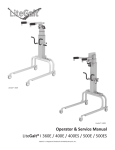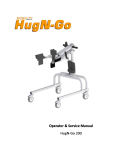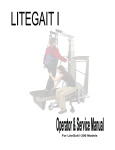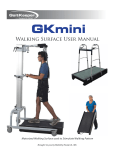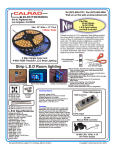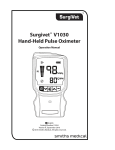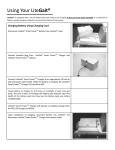Download Operator & Service Manual LiteGait® I 300E
Transcript
Operator & Service Manual LiteGait® I 300E SERIAL NUMBER Serial Number of Your Device: Note: Please keep your serial number in a safe and secure location. The serial number must be provided when seeking service for your LiteGait® device. The serial number provides us access to technical information regarding your device. www.LiteGait.com 1-800-332-9255 IMPORTANT SAFETY INSTRUCTIONS ***WARNING*** READ ALL INSTRUCTIONS BEFORE USING LiteGait® MAXIMUM PATIENT WEIGHT: LiteGait® I 300E: 300 lbs MAXIMUM UNIT HEIGHT: 7 Feet 5 Inches Use only under the direct supervision of a health care professional or caregiver Brakes should remain in the locked position at all times until transfer from one location to another is initiated. Operate on smooth and level surfaces ONLY. www.LiteGait.com 1-800-332-9255 Dear LiteGait® User, CONGRATULATIONS on your recent purchase of LiteGait®, the most innovative gait and balance therapy training system available today. As you know, LiteGait® can be used with a wide variety of patient impairment levels and conditions. If you have questions about the possible uses of LiteGait® with particular patients, or are in need of some ideas for ways to use LiteGait® more effectively, please do not hesitate to contact us for information relating to your individual situation. Our website also offers valuable information. Like all quality therapy equipment, LiteGait® requires regular inspections. Enclosed is a check list for your convenience. Please complete the checklist every 6 months to ensure the efficient, safe, and effective operation of the LiteGait®unit. If you should find a problem with a LiteGait® part, please contact the Technical Support Department immediately. Here are some resources, which will be of help to you: CLINICAL SUPPORT: TECHNICAL SUPPORT: WEBSITE: USER FORUM : Sincerely, Customer Service Department Mobility Research [email protected] [email protected] www.LiteGait.com www.LiteGait.org Table of Contents Unpacking and Assembly .................................................................................. 10 Unit Diagram ..................................................................................................... 13 About Your Unit ................................................................................................. 13 USING Your LiteGait® ......................................................................................... 14 I. Control Unit ................................................................................................. 14 II. Charging LiteGait® ....................................................................................... 14 III How to Adjust Yoke Height .......................................................................... 15 IV. FlexAble ..................................................................................................... 15 V. Adjusting Handle Bars ................................................................................. 15 VI. Base and Casters ........................................................................................ 16 VIII. BiSym Scale Optional .............................................................................. 17 VII. Harness Application .................................................................................. 20 Training with LiteGait® ....................................................................................... 22 Unit Care and Maintenance .............................................................................. 25 Troubleshooting ................................................................................................ 28 Parts List ........................................................................................................... 30 Resource Directory ............................................................................................ 32 Limited Warranty Certificate .............................................................................. 33 9 www.LiteGait.com 1-800-332-9255 LiteGait® Assembly 5.) Loosen handle bar knobs and raise handle bars. Tools Required: Scissors 1/2 inch socket or open-end wrench 5/16 inch Allen wrench (provided) LiteGait® I Assembly Instructions: Read below & follow pictures. NOTE: Two people are required for safe assembly. 6.) Remove cardboard harness and accessories box. NOTE: Your LiteGait® may look different than the following images. NOTE: If you have any questions during installation, please contact Mobility Research Technical Support for assistance. 1.) Inspect shipment and note any visual damage to box and/or crate 7.) Open cardboard harness and accessories box. 2.) Remove screw located at the bottom of crate 8.) Inspect contents of harness and accessories box for damage. 3.) Lift off exterior box in order to expose equipment 9.) Carefully cut all black plastic straps securing base to pallet. 4.) Examine contents. Report any damage to equipment immediately to Mobility Research Technical Support 10.) Using both people, remove base from pallet. CAUTION: DO NOT USE UTILITY KNIFE TO OPEN BOX 10 www.LiteGait.com 1-800-332-9255 11.) Position base over pallet with actuator near base as pictured. 17.) Lower handle bars on actuator and tighten knobs before lifting. 12) Cut and remove plastic wrap from base compartment 18.) Lift actuator from pallet to base using two people 13.) Remove hand switch from inside base compartment and set aside for installation of actuator 19.) Orient the actuator on base such that the yoke and handle bars are facing the same direction as the legs of the base. 14.) Prepare base for installation of actuator. Remove four black steel bolts from base using allen wrench in small box. 20.) Insert bolts and hand tighten. Make sure while one person is inserting bolts, the other is holding the actuator. 15.) The actuator cord will sit between the edge of the base and the plate on the actuator. Pull actuator cord, out and rest on base prior to installation of actuator. 21.) Tighten the bolts until snug using the allen wrench. 16.) Remove screws securing actuator to pallet. 22.) Insert the actuator connector into the back of the actuator. CAUTION: DO NOT over tighten the bolts. 11 www.LiteGait.com 1-800-332-9255 (Optional) BiSym Assembly 23.) Twist the red button clockwise to turn on the LiteGait®. 1.) Remove Digital BiSym card board box from harness and accessories box 24) The battery capacity display should display four solid black bars indicating a full charge. If the display does not show any solid black bars check battery connection. 2.) Open Digital BiSym Box card board box and inventory the following. Digital BiSym Display Digital BiSym Charger 25.) Verify the connection of the power system to the actuator by pressing the up and down buttons on the hand switch. 3.) Slide Digital BiSym Display onto Digital BiSym bracket near the yoke of the LiteGait. 26.) Carefully remove all shrink wrap from LiteGait®. 4.) Connect the load cell cables marked LEFT and RIGHT to the LEFT and RIGHT Ports on the side of the Digital BiSym Display CAUTION: DO NOT USE UTILITY KNIFE TO REMOVE SHRINK WRAP 5.) Connect the Digital BiSym Battery Cord exiting the top of the LiteGait® to the short cord exiting the Digital BiSym Scale NOTE: THE DIGITAL BISYM IS CHARGED BY CONNECTING THE DIGITAL BISYM CHARGING CABLE TO THE DIGITAL BISYM BATTERY CORD. NOTE: DIGITAL BISYM SHOULD BE CHARGED ONCE A MONTH OVERNIGHT NOTE: DO NOT DISCARD DIGITAL BISYM CHARGING CABLE 12 www.LiteGait.com 1-800-332-9255 LiteGait® Diagram 1 1. Yoke 2 2. Buckle Assembly 3 3. FlexAble 4 4. Handle Bar Assembly 5 5. Battery Compartment 11 6 6. Hand Switch 10 7 7. Total Locking Casters 9 8. Directional Locking Casters 9. Base/Frame 10. Control Unit 11. Actuator 8 NOTE: Your LiteGait® may look different than image above CONTROL UNIT: Junction box mounted in the base for the battery power, handheld switch and contains electrical safety protection circuitry. The battery pack connects to this unit and is also located within a compartment of the actuator. HANDLEBARS: Unit has two adjustable handlebars. The handle bars are attached to the unit using two knobs. About Your LiteGait® LiteGait® is comprised of several parts. YOKE: Y-shaped support that has four female buckles at the ends and is attached to the actuator with a flat plate secured by four bolts. OVERHEAD STRAPS: Four 44” long adjustable straps with male connectors at one end and padded female buckles at the opposite end. The male connectors attach to the yoke buckles and the female buckles attach to the harness providing postural support for the patient. HARNESS/GROIN PIECE: Adjustable wrap with a buckle closure in the front and three adjustable straps on each side. The four male connectors at the top of the harness that attach into the female buckles of the overhead straps. The four female buckles at the bottom of the harness allow for the connection of the groin piece. The H-shaped stitching on the groin piece denotes the top (or body side) of the piece. ACTUATOR: The mechanism that raises and lowers the yoke. The actuator consists of a concentric expanding and retracting square tower that houses the DC motors, gearing and the screw mechanism. It also provides the structural base to which the adjustable handlebars are attached. NOTE: Over tightening the knobs may cause damage. BASE: Two horizontal bars connected by two Ushaped tubes. The base moves freely over ground or can be locked into place during use over a treadmill. However, your unit must be locked into place at all other times. CASTERS: Four casters are attached to the base. The two casters on the left side are total locking and the two casters on the right are directional locking. Be certain to lock both caster brakes when using the unit over a treadmill or when connecting the patient to the unit. WARNING: NEVER leave patient unattended in the unit. BISYM (Optional): Provides a display of the pounds/ kilograms of support provided by each arm of the yoke. The load cells that are installed in the yoke sense the load on the yoke and feed it to the BiSym Scale for processing and display. 13 www.LiteGait.com 1-800-332-9255 Using Your LiteGait® Charging LiteGait LiteGait® is equipped with a 24 volt battery pack that needs to be charged on a weekly schedule. To recharge your battery follow the steps below. The battery and charging cord are located in the compartment on the left of the actuator Control Unit Control Unit is the part of the LiteGait® that controls the adjustment of the actuator. The control STOP and Plug Icons box consists of the following features. Red ON/OFF Button Battery Charge Indicator ON and CHARGE LEDs Emergency Down Button 1.) Remove cover to battery compartment Red ON/OFF Button The emergency ON/OFF Button is the ON/OFF switch for the LiteGait. To turn the device on, rotate the red button clockwise and it should pop outward. To turn the device off press the red button down. The device also automatically turns off when connected to a power outlet 2.) Locate charging cord 3.) Plug charging cord into appropriate 110V or 220V power outlet. ON OFF When the LiteGait® is plugged in to charge it automatically shuts off. The LiteGait® is only battery powered will not operate while connected to a power outlet. Green LED indicates when the device is plugged into a power outlet. Yellow LED indicates when the LiteGait® battery is taking a charge. The LED light shuts off after the battery is fully charged The charging current automatically tapers off the when the batteries are nearly charged. Coil adapter cord into Battery Compartment and then replace battery cover. Battery Charge Indicator The Battery Charge Indicator shows the idle charge on the battery while the device is on. The indicator displays the charge in 25% increments. 4 solid black bars indicates a full charge on the battery. A plug icon appears in the 50% capacity bar when charge is down to 25%. The LiteGait® should be charged when the plug icon appears. When the battery charge is 0% the display will show a STOP and a Plug icon, this indicates that the device needs to be charged as soon as possible. When the device is turned OFF or is connected to an outlet the display indicates the STOP and Plug Icons. 100% Charge 25% Charge NOTE: LiteGait® Battery Should be charged overnight AT LEAST ONCE PER WEEK. NOTE: Digital BiSym Scale (OPTIONAL) utilizes a second battery located at the top of the LiteGait ® that should be charged overnight AT LEAST ONCE PER MONTH.MONTH 0% Charge 14 www.LiteGait.com 1-800-332-9255 Using Your LiteGait® How to Adjust Yoke Height FlexAble The LiteGait® powered actuator column is raised and lowered by a hand switch with two up and two down arrows. FlexAble allows for the rigid yoke to become position flexible, with up to 5 inches of travel. Thus, you can maintain the rigid yoke position or make it flexible – giving the patient the option to experience more of their balance and weight bearing at their own discretion. Flexible Support Loosen the star knob on the bottom of the FlexAble. The amount of deflection can be varied by the amount the knob is loosened Rigid Support Tighten the star knob completely on the bottom of the FlexAble Raising the Yoke Verify that LiteGait® has clearance above the yoke. Depress the button with the up arrow on the hand switch. Release the button when the yoke is at the desired height. Lowering the Yoke Verify that LiteGait® has clearance below the yoke. Depress the button with the down arrow on the hand switch. Release the button when the yoke lowers to the desired height. NOTE: With the FlexAble or flexible, the LiteGait® yoke and harness still provide full support to the LiteGait® User. Adjusting Handle Bars Raised Raising and Lowering the Handle Bar Loosen each knob in equal portions. The knobs should only need to be turned once to free the handle bars. Once the knobs are loosened slide the handle bars to the desired height. Hand tighten both knobs equally. Again, the knobs should only need to be tightened one rotation Lowered Emergency Lowering of Yoke If the down buttons fail to lower during normal use due to a low battery. There is an auxiliary down button that can be pressed to lower the device. Using a pen tip or small screwdriver, press the black emergency down button, this lowers both columns of the LiteGait® when pressed. CAUTION: Using the Emergency Down Button may damage battery for future use. Use only in case of emergency. 15 www.LiteGait.com 1-800-332-9255 Using Your LiteGait® Locking and Unlocking Casters Adjusting Handle Bar Configuration To adjust the configuration, perform the following steps. Press the button on the quick release handle bar pin and pull outward. Adjust handle bar insert to desired length and orientation. Press the button on the quick release handle bar pin and insert handle bar pin. The pin can be inserted vertically and horizontally. Press tab to lock Locked Caster Total Locking Casters Total locking casters are indicated by a red BRAKE sticker on the locking lever. To lock the total locking casters, press the tab until the brake snaps into place. The caster will lock the swivel of the caster and rotation of the wheel. Locking all four casters will make the device stationary. NOTE: While locking the caster prevents rolling of the unit, it DOES NOT prevent the unit from sliding on a sloped, slippery floor. The unit should only be used on a flat floor away from stairs or ramps. NEVER leave a patient unattended in the unit. WARNING: LiteGait® Handle Bars are designed to be used as a balance aid while using the LiteGait. Excess loading of the handle bars may damage handle bars. Avoid Having patients lift their weigh using the handle bars. Directional Locking Casters Directional lock casters are indicated by a green STEER sticker in the locking lever. To lock the directional locking casters, press the tab and align the caster with the frame. Once Aligned this locks the swivel of the casters and is beneficial for walking in a straight path or placing LiteGait® over a treadmill. Once the unit is positioned over a treadmill, all four caster brakes need to be locked Directional Locking Casters with Treadmill Position LiteGait® near the treadmill (or where you wish the patient to begin walking). Base and Casters Roll LiteGait® towards the front of the treadmill, until the casters line up parallel to the treadmill (or parallel to the path the patient will follow—a hallway for example). LiteGait® is equipped with four casters. There are two total locking casters and two directional lock casters. Each leg has one type of casters, the total locking are mounted on the Left Leg the Total Locking are mounted on the right. Press the directional locks to lock swivel of casters LiteGait® can now be easily rolled back and forth over the treadmill or on a straight path in the therapy room or hallway. Total Lock Directional Lock 16 www.LiteGait.com 1-800-332-9255 Using Your LiteGait® BiSym Scale (Optional) BiSym is a unique option available with LiteGait® to measure unilateral or bilateral support. LiteGait®’s special design includes a two-armed yoke which holds the patient above each shoulder. From these two points, the harness system can be adjusted to provide as much or as little support required to each side of the body. The range of support can vary on each side from full to no support. BiSym measures this asymmetric support at any given time during the gait cycle. Each arm of the yoke is instrumented with a load cell with electrical connections to a box at the base of the yoke. This electronic box powers the load cells, processes the signals and displays the supported loads of each arm or total support on a display unit. This can be used for charting of therapy progression as well as accommodation of weight bearing status. Optionally, digital outputs representing the supported loads on both sides of the body are provided for digital recording on to a PC. These signals vary as the weight bearing load changes from the right to left side during the gait cycle. This can be used as biofeedback for the patient. The more weight bearing by the patient = better posture = less work by machine = smaller BiSym reading. Connecting the BiSym Connect Corresponding Load Cell wires from BiSym ready LiteGait® yoke into BiSym Scale. Slide BiSym Scale onto the pre-installed bracket at the base of the yoke. NOTE: Proper installation will leave the monitor visible to the patient supported in the LiteGait® Using the BiSym Scale Press any button to turn the BiSym Scale on. The BiSym Scale has an AUTO SHUT-OFF that can be adjusting during the CHANGE SETTING? mode (see below) Changing Display Modes Press set to cycle through mode displays. Right Support Left Support Difference (Right - Left) Total (Right + Left) Both Supports The top row displays the supported load in pounds (lb) or Kilogram (kg) depending on the setting. The bottom row displays a bar graph representing the value in the top row as a percentage of the specified weight (default value 100lb). Right Support Left Support Total (Right + Left) Both Supports 17 Difference (Right - Left) www.LiteGait.com 1-800-332-9255 Using Your LiteGait® Changing BiSym Settings To enter settings mode Press and hold the SET button for 3 seconds or until display shows CHANGE SETTING? Press Set a second time to confirm change settings After selecting the CHANGE SETTING? mode the BiSym will cycle through three screens Weight Unit Setting Auto Shut-Off Setting User/Patient Weight Setting Selecting the units measurement for weight reading on the scale After selecting the CHANGE SETTING? mode, the Weight Unit Setting screen will be displayed for three seconds. Press the set button to toggle between pounds (lb) and kilograms (kg). Adjusting the Auto Shut-Off time After the Weight Unit Setting screen, the Auto Shut-Off Setting Screen will be displayed. Press the CAL button while on the Auto Shut-Off setting screen to adjust the Auto Shut-Off. The Auto Shut-Off should be set between 3 and 60 minutes WARNING: SETTING THE AUTO SHUT-OFF TO 0 WILL DISABLE THE AUTO SHUT-OFF. THIS WILL DISABLE AUTO OFF FUNCTION ON THE BISYM SCALE RESULTING IN NO SHUT OFF OF THE BATTERY. Setting the User/Patient Weight Press the Set button to add 10 pounds at a time to the pre-set value of 100. Set the value to the patient weight within the nearest 10 pound and the graphic display represents the percentage of the set weight being supported. The default setting to 100 reflects the actual weight of the patient. Charging the BiSym Scale The BiSym scale battery is charged by a charger separate from the LiteGait® device. The BiSym battery should be charged for 6 - 8 hours or overnight once per month. The BiSym is connected to the BiSym Battery cable located at the top of the LiteGait. Disconnect the battery cable from the BiSym Scale. Plug the male end of the charger cable into the female end of the battery cable. Plug the charger into the appropriate 110 or 220 volt outlet. 18 www.LiteGait.com 1-800-332-9255 Using Your LiteGait® Setting the BiSym Zero Calibration The zero calibration should only be set while the harness is attached to the LiteGait. Please make sure to connect the harness to the overhead straps prior to setting the zero calibration. There should be no additional weight attached to the harness. Zero Calibration should be performed WITHOUT a patient in the device. Press the CAL button and hold for three seconds or until the monitor displays “ZERO CALIB” Confirm by pressing the SET button Set the Left Zero by pressing the Set Button Set the Right Zero by pressing the Set Button Test zero calibration by toggling through the weight readout screens. All screens should be displaying a zero pound or kilogram readout. 19 www.LiteGait.com 1-800-332-9255 Using Your LiteGait® Harness Application Preparation 1. Pick the appropriate harness and groin piece for the patient (based on patient girth). 2. Estimate the harness girth before placing on the patient by folding the harness in half so that the ends meet. Then, hold the harness in front of the torso to estimate the width from one side of the body to the other. 3. Tighten or loosen the 3 rows of side straps on each side of the harness. (To loosen the side straps lightly pull up on the black tabs on the side buckles.) 4. Keep the harness folded in half and align the top buckles so that they are adjacent with each other. 5. Take the groin piece and adjust the groin strap padding towards the center of the strap before putting it on. 6. Adjust the front groin straps so they are equal in length. 7. Adjust the back groin straps so they are equal in length. 8. Attach the groin piece to the back of the harness. 9. The side of the groin piece with the H-outline stitching (most padded) will go against the patient’s body. How to put on the Harness The harness was designed to support a patient in an upright position, allowing for full hip extension. This upright posture plays a critical role in the effectiveness of the gait therapy performed with partial weight bearing. The front of the harness wrap refers to the point at which the two ends of the harness meet. The harness can be worn with the closure either in the front or in the back. There are four buckles on the top and bottom of the harness wrap. The four top buckles extend beyond the harness from the top seam and attach to the LiteGait® straps. The bottom four buckles attach to the groin piece and do not extend past the bottom seam of the harness. Harness Application – While Standing 1. Wrap the harness around the patient’s torso. 2. Place the lowest strap over the greater trochanter. 3. Attach the front buckles. 4. Tighten the lowest straps first 5. Attach the groin piece (see Groin piece attachment section). 6. Attach harness to LiteGait® (See Connect the Harness to your LiteGait® ) Step 1 Step 2 Step 3 Step 3 Step 5 Step 6 20 www.LiteGait.com 1-800-332-9255 Using Your LiteGait® Groin Piece Attachment 1. Attach the groin piece to the front harness buckles. The stitched side of the groin piece should be facing up against the body. 2. Hold the padded part of one end of the groin piece with one hand. 3. Pull it against the patient’s leg. Keep holding it while the other hand pulls the free end of the groin strap. 4. Tighten the groin strap snugly so there is NO slack. 5. Repeat on the other side. 6. Pull out any wrinkles or bunching from the patient’s clothing. 7. Sit the patient up or stand the patient, if safe NOTE: ENSURE AT ALL TIMES THAT THE BOTTOM STRAP OF THE HARNESS IS AT THE LEVEL OF THE GREATER TROCHANTER (HIP JOINT CREASE). NOTE: CONTRARY TO WHAT MAY SEEM REASONABLE, A LOOSE GROIN PIECE DOES NOT IMPART GREATER COMFORT TO THE PATIENT, BUT ALLOWS THE HARNESS TO SLIDE UP THE TRUNK, PUTTING UNWANTED LOAD/FORCE ON THE GROIN AREA. TIGHTEN THE GROIN STRAP SO THAT NO SLACK REMAINS IN THE STRAPS. THIS ASSURES THAT THE HARNESS WILL NOT RIDE UP ON THE PATIENT. Connect the Harness to your LiteGait® 1. Lock the all four casters to make the device stationary. 2. Adjust the yoke to the correct position, giving the patient approximately 5 to 6 inches of head clearance 3. Extend the overhead straps until they are long enough to reach the upper connection on the harness. Attach the four buckles that hang from the overhead straps to the appropriate buckles on the harness. Pull the straps until taut. 4. With the patient in the harness , bring the patient into a standing position directly under the yoke buckles. Have the patient hold the handle bars. Adjust the height of the handle bars to suit the patient. 5. The unit can now be used for ground therapy , or to assist the patient in stepping onto the treadmill. 6. With higher level patients, the unit may be positioned over the treadmill prior to buckling the patient in place. WARNING: UNDER NO CIRCUMSTANCES SHOULD THE PATIENT HAVE ALL WEIGHT REMOVED FROM THE LEGS FOR MORE THAN TWO MINUTES AT A TIME Leg Strap Instruction Leg Straps are abductor straps that replace the groin piece. They are sized to match either 1” plastic buckles as in WalkAble and Junior harness or 1.5” plastic buckles as in adult and small adult harness or the metal buckles of the bariatric harness. They consist of a pair of self-Velcro wraps with straps to connect to the harness. The wraps are applied below the bulk of the thigh and above the knee so as not to interfere with knee function but grab the upper leg tightly. The orientation of the wrap is such that the strap is perpendicular to the ground and pointing up toward the hip and is on the outside of the leg. Find the place where the strap splits into two. Place it right on the hip joint axis of rotation. The two straps departing from that spot should be pointing toward the buttonholes on the harness. The plastic female buckles that come out of the button holes (they normally receive the male buckles on the groin straps) are now plugged into the male buckles at the end of the leg strap. These straps are tightened while keeping the perpendicular strap centered between them. The strap that goes to the thigh wrap needs to be tightened to put preload the harness wrap. The harness will transfer the support from the LiteGait® Yoke through the side straps to the thigh wrap. Any slack in the straps (or as always a loose harness wrap) will be compensated by an upward shift of the whole harness until that slack is taken up. To prevent loss of harness position you must take up the slack and account for soft tissue give when tightening the side straps. CAUTION: SITTING WHILE IN THE LEG STRAPS WILL DISPLACE THE HIP AXIS OF LOCATION AWAY FROM AND OUT OF THE LEG STRAPS; REPOSITIONING OF THE LEG STRAPS WILL BE NECESSARY. 21 www.LiteGait.com 1-800-332-9255 Training with LiteGait® Over Treadmill 1. The yoke height should be adjusted so that the top is approximately 5 inches above the patient’s head when standing on the treadmill, so that the hardware hanging from the yoke is just out of the reach of patients head. 2. Lock the directional locks and position the unit over the treadmill. 3. Position the patient at the rear of the treadmill walking surface, facing the treadmill. The patient should either be seated in a wheelchair, on a chair, or standing with the help of an assistive device on the ground at the rear of the treadmill. 4. Roll the unit to the rear of the treadmill and lock the caster brakes. 5. The patient may hold onto the adjustable handlebar. Stand the patient up. For lower level patients, skip this step until the patient is connected to the LiteGait® unit. 6. Attach the four buckles on the overhead straps hanging from the yoke to the harness. (Be careful to attach the front straps to the front buckles and the back straps to the back buckles.) 7. Tighten each strap by gently lifting up on the connected section of the strap and pulling down on the loose end of the strap simultaneously. Repeat the procedure with all four straps, making sure that the straps are of equal length when finished. 8. Double check that all four straps have been connected to the appropriate buckles on the harness and all the straps have been tightened equally. 9. At this point, the patient should be securely buckled and attached to the unit. 10. For the seated patient, raise the yoke until the patient is in a standing position. Retighten each strap as necessary. 11. Standing beside the patient, slowly roll the unit forward toward the front of the treadmill. This position will allow you to both roll the unit and assist the patient with stepping forward onto the treadmill walking surface. 12. When the patient steps up on the treadmill, quickly re-tighten all four straps as necessary to increase the support provided by the unit. 13. Continue to roll the unit over the treadmill as far forward as possible, while the patient walks. 14. Once the unit is at the front of the treadmill, lock the caster brakes. 15. Double check to see that the unit is locked into place and that the patient is in the center of the treadmill walking surface. 16. Adjust the handlebar to the appropriate height. 17. To exit the unit, reverse the process. 22 www.LiteGait.com 1-800-332-9255 Training with LiteGait® Over Ground 1. Alternatively, lower the yoke so that it is approximately 5 inches above the patient’s head when sitting. 2. The patient should either be seated in a wheelchair, on a chair, or standing on the ground with the aid of an assistive device. 3. Position the unit over the patient. 4. Lock the caster brakes. 5. Loosen the straps and connect the appropriate straps to the harness being sure to connect the front straps with the front buckles and the back straps with the back straps. 6. Stand the patient up. (The patient may hold onto the adjustable handlebar.) 7. Tighten all four straps until the patient is standing in the proper upright posture. 8. Make any postural adjustments by tightening or loosening the appropriate strap. 9. Adjust the handlebar to the appropriate height. 10. As the patient begins to move over ground, several options are possible depending on treatment goals and the patient’s ability: 11. Push the unit matching the patient’s rate of walking. 12. Push the unit faster to increase the patient’s rate of walking. 13. Allow the patient to push the unit with or without assistance. 14. Allow the patient to walk forward, backward, or laterally. 15. Adjust the yoke height so that it is approximately 5 inches above the patient’s head when standing. NOTE: THE CASTER BRAKES SHOULD BE LOCKED WHENEVER THE UNIT IS STATIONARY. RELEASE THE CASTER BRAKES ONLY FOR MOVEMENT OF THE UNIT. Over Treadmill Over Ground 23 www.LiteGait.com 1-800-332-9255 This page intentionally left blank. 24 www.LiteGait.com 1-800-332-9255 Unit Care and Maintenance LiteGait® Maintenance Your LiteGait® has been specially designed to be durable and relatively maintenance free. The frame is constructed from high strength steel, and has been painted with a special powder coat to resist rust and scratches. Cleaning Frame: Frequency * FOLLOW STANDARD FACILITY INFECTION CONTROL PROCEDURES. Cleaning Agent DILUTED WINDEX TYPE CLEANING SOLUTION Drying Method WIPE DRY WITH CLEAN CLOTH Special Cleaning WD-40 CAN BE USED TO REMOVE DIRT OR OILY SPOTS. Harness Maintenance All harnesses and groin straps, including the iHarness, can be washed in hot water up to 80°C according to facility infection control guidelines. Harnesses should be dried with low or no heat tumble dry. The iHarness and the overhead LG straps can also be wiped with disinfection wash, per facility infection control procedures. Bleach, if used, will shorten the life of the cloth material on the harness Standard Harness & Groin Pieces iHarness & iGroin Pieces Frequency Facility infection control guidelines Cleaning Agent Facility infection control guidelines Water Temperature Drying Method Overhead Straps WASH IN UP TO 176°F (80°C) HARNESSES SHOULD BE DRIED WITH LOW OR NO HEAT TUMBLE DRY WIPED WITH DISINFECTION WASH, PER FACILITY INFECTION CONTROL PROCEDURES Special Cleaning Harness Storage The harness has been made of an durable fabric to retain its shape and effectiveness through many uses and washings. However, it is imperative that the harness be stored properly to prevent damage to the buckles. When not in use, store the harness in a place or area that will prevent the harness from being stepped on or rolled over. The crushing downward force of a wheel chair or cart rolling over the harness would damage the buckles, making the harness ineffective and unsafe for further use. 25 www.LiteGait.com 1-800-332-9255 Unit Care and Maintenance To maintain the highest quality of function and safety, it is extremely important that you conduct regular maintenance checks of your LiteGait® unit and all of its parts. Please refer to the following checklist for an inspection guideline. If you should have any questions concerning the functional status of any of the LiteGait® parts, please contact the Technical Support department immediately at [email protected]. It is recommended that you inspect the LiteGait® unit and all of its parts every 6 months. Please rate the function of each item as follows: 1 = POOR 2 = FAIR 3 = GOOD 4 = EXCELLENT. A rating of FAIR (2) or POOR (1) indicates that that part should be immediately replaced to maintain the safe and effective use of the equipment. Check All Components Functionality Cracks or Tears Exposed or Frayed Wires Loose/Rusted Bolts Discoloration/Degradation Check List Recommended Replacement Schedule Battery 24-30 Months Charger * Hand Switch * Harness Wrap 18-24 Months Groin Pieces 18-24 Months Overhead Straps * Casters * Knobs / Pins * Grips / Covers / Caps * Buckles * Base * Actuator * *Replace As Needed Based on Condition Please Send Copy of Completed Form Every 6 Months to Mobility Research Technical Support Fax: 480-829-0737 Mail: Mobility Research — Technical Support P.O. Box 3141 Tempe, AZ 85280 Email: [email protected] Website: http://litegait.com/techsupport.html Maintenance Contact Information Facility Name City State First Last Title Phone Fax Email Model Serial Number 26 www.LiteGait.com 1-800-332-9255 Unit Care and Maintenance 27 www.LiteGait.com 1-800-332-9255 Troubleshooting - Power System Symptom: Actuator Does Not Raise or Lower 1. Possible Cause: Low Battery Charge / Battery need to be Replaced. 3. Possible Cause: Loose Cable Connection 4. Possible Cause: Other Power System Issue Symptom: Battery Does Not Charge 1. Possible Cause: Device is Not Connected to Power Outlet Resolution: Charge the battery following the appropriate charging instructions until full charge. If charging does not resolve issue contact Technical Support for replacement battery information. Resolution: Disconnect cables from Control Box. Firmly reconnect cables ensuring a secured connection Resolution: Contact Technical Support for further troubleshooting. Resolution: Connect charge cable to appropriate 110V outlet. (220V for International Customers when applicable). 2. Possible Cause: Charging Cord is Not Connected Properly Resolution: If the green LED indicates the charger is connected to a power outlet. Once the charger is connected the green LED turns red. Once the battery is fully charged, the LED turns back to green. 3. Possible Cause: Power Outlet is Faulty Resolution: Check Outlet with another electrical device to ensure proper function of outlet. Resolution: If battery is not charged for an extended period the voltage may be too low to charge. Contact Technical Support for replacement battery information. Resolution: Contact Technical Support for replacement battery information 4. Possible Cause: Battery not been charged for an extended period. 5. Possible Cause: Battery has been in service for 30 months or more. 6. Possible Cause: Other Power System Issue Symptom: Battery Does Not Hold Charge 1. Possible Cause: Low Battery Charge Resolution: Contact Technical Support for further troubleshooting instruction. 2. Possible Cause: Battery Needs to Be Replaced Resolution: Contract Technical Support for replacement battery information. Resolution: Charge the battery following the appropriate charging instructions until full charge. Troubleshooting - Casters Symptom: Device Does Not Roll Easily 1. Possible Cause: Resolution: One or both of the Total Locking Casters are Locked. 2. Possible Cause: One or both Directional Locking Caster are misaligned The Total Locking Casters are labeled with a red BRAKE sticker. Unlock the Total Locking Casters. Resolution: The Directional Locking Casters are labeled with a green STEER sticker and engage when the caster is aligned with the leg of the base. If the LiteGait® does not move forward and backward when the directional locking casters are locked they are not aligned properly. Contact Technical Support for further repair instruction. Resolution: Contract Technical Support for repair information and. 3. Possible Cause: One or more of the casters are loose and are no longer secured to the frame or are damaged Symptom: Device Does Not Stay Stationary when Locked 1. Possible Cause: Resolution: One or more of the casters is not locked. Make sure all four casters are locked to make the device stationary. NOTE: If all casters are locked appropriately, contact Technical Support for further information. 28 www.LiteGait.com 1-800-332-9255 Troubleshooting - Harness Symptom: Patient is complaining of groin or harness discomfort. 1. Possible Cause: Resolution: The harness wrap and/or the groin piece are The harness and groin piece should be securely tightened from the start.* The not tight enough. harness wrap should be tight enough to grab on to the fatty tissue around the abdomen. The groin piece should then be tightened securely to keep the harness from riding up on the patient and creating unwanted pressure in the groin area. A towel or a piece of foam can be wrapped around the patient’s abdomen for added padding if needed. Symptom: Harness is riding up on the patient causing pressure in the groin piece area 1. Possible Cause: Resolution: Groin piece has slack, harness rides up makThe bottom two straps on the harness wrap must be tightened securely, the ing groin straps the only source of support top one only if it rests below the rib cage. Applying the harness and groin piece loosely will cause them to slide upward.* Symptom: Frontal overhead straps are causing discomfort in the chest area of female patients. 1. Possible Cause: Resolution: The distance between the overhead straps places load on breasts. Use an extender to increase the front panel size and distance between the overhead straps possibly avoiding the chest tissue. Conversely, the harness wrap placed on the patient with opening in the back results in overhead straps getting closer to each other in the front. Symptom: The overhead straps slip off of patients shoulders 1. Possible Cause: Resolution: The overhead straps are too far apart. Place the harness wrap with the opening in the back. This will bring the overhead straps closer to each other. Symptom: The patient cannot stand to properly position and tighten the harness and groin piece. 1. Possible Cause: Resolution: Patient is too weak or unsafe to stand Apply the harness in supine position. Avoid harness application in sitting as it reinforces flexed hip position. Troubleshooting - Digital BiSym (Optional) Symptom: BiSym Display Is Not Powering On 1. Possible Cause: Battery is Not Connected to BiSym Display 2. Possible Cause: Low Battery Charge 3. Possible Cause: Battery Needs to be Replaced Symptom: BiSym Display is Not Reading Weight 1. Possible Cause: Load Cell Cables are Not Connected Resolution: Connect Battery cable to BiSym Display Resolution: The Digital BiSym is powered by a separate battery located near the top of the LiteGait®. Charge the BiSym Battery following the Digital BiSym charging procedure. Resolution: Contact Technical Support for replacement battery information. Resolution: On the left side of the scale there should be three cables, two that look like phone jack connectors and one that connects to the top of the LiteGait®. Confirm that the cables are securely attached to the BiSym display. NOTE: If load cells are connected properly and the BiSym continues not to read weight, contact Technical Support for further information. Symptom: BiSym Display is Not Reading Zero When No Weight is on LiteGait. 1. Possible Cause: Resolution: Harness is Moving Slightly Any movement in the harness may cause some noise in the BiSym Scale reading. A reading near zero is a normal occurrence. 2. Possible Cause: Resolution: BiSym scale requires Zero Calibration Refer to Zero Calibration Instructions from BiSym section of manual. Symptom: BiSym Does Not Automatically Power Down. 1. Possible Cause: Resolution: Auto Shut OFF is set too long or set to ZERO Refer to the Change Settings from BiSym section of manual. 2. Possible Cause: Issue with BiSym Resolution: Contact Technical Support for further troubleshooting instruction. 29 www.LiteGait.com 1-800-332-9255 Parts List LiteGait® I Parts List – Harness and Accessories Standard Adult Harness Harness Wrap w/Overhead straps, covers and groin pieces HA 1 Standard Adult Harness Wrap A rigid, washable cloth wrap used with attachments that provide postural support to the patient HA-A 1 10.5” Groin Piece for HA 10.5” Padded, adjustable piece which connects to the harness and is positioned between the legs. HA-G 1 13” Padded, adjustable piece which connects to the harness and is positioned between the legs. HA-H 1 9” Groin Piece for HA (OPTIONAL) 9” Padded, adjustable piece which connects to the harness and is positioned between the legs. HA-F 1 Harness Extender (OPTIONAL) 7.5” extension to plug into front of the harness wrap. PHAEX 1 HSCS 2 13” Groin Piece for HA HA / HS Leg Straps (OPTIONAL) Adjustable piece which connects to the harness and is positioned around the legs for small adult / Adult Harness Small Adult Harness Harness Wrap w/Overhead straps, covers and groin pieces HS 1 Small Adult Harness Wrap A rigid, washable cloth wrap used with attachments that provide postural support to the patient HS-A 1 9” Groin Piece for HS 9” Padded, adjustable piece which connects to the harness and is positioned between the legs. HS-F 1 10.5” Groin Piece for HS 10.5” Padded, adjustable piece which connects to the harness and is positioned between the legs. HS-G 1 HSCS 2 13” Groin Piece for HA (OPTIONAL) HA / HS Leg Straps (OPTIONAL) Junior Harness 13” Padded, adjustable piece which connects to the harness and is positioned between the legs. Adjustable piece which connects to the harness and is positioned around the legs for small adult / Adult Harness HJ 1 Junior Harness Wrap A rigid, washable cloth wrap used with attachments that provide postural support to the patient HJ-A 1 6” Groin Piece for HJ 9” Padded, adjustable piece which connects to the harness and is positioned between the legs. HJ-D 1 8” Groin Piece for HJ 10.5” Padded, adjustable piece which connects to the harness and is positioned between the legs. HJ-E 1 9” Groin Piece for HA (OPTIONAL) 9” Padded, adjustable piece which connects to the harness and is positioned between the legs. Diaper Harness Harness Wrap w/Overhead straps and covers HDJ 1 Diaper Harness Wrap A rigid, washable cloth wrap used with attachments that provide postural support to the patient HDJ-A 1 Overhead Strap Seatbelt like straps with one male and one female connection. The male end connects into the buckles on the yoke. The female end connects into the buckles on the harness. HS-B 4 Overhead Strap Cover The soft, cushioned material covering the female buckles of the straps that attach to the harness. HS-C 4 The electrical system that controls the positioning of the actuator. PS35E 1 A split red and green color coded connection cord that electrically connects the control box to the actuator. PS35E-A 1 24V battery pack. PS35E-B 1 The electric junction box. PS35E-C 1 Charger Cord The AC adapter cord that plugs into a wall outlet and the control box. PS35E-D 1 Hand Switch The switch connects to the control box. The buttons allow for the adjustment of the height of the device. PS35E-E 1 Battery Cover Rectangular metal plate that covers batteries. PS35E-G 1 Control cover Rectangular metal plate, with a wedge removed, which covers the Control Box. PS35E-H 1 Harness Wrap w/Overhead straps, covers and groin pieces LiteGait® IParts List – Power System POWER SYSTEM Actuator Cord Battery Control Box 30 www.LiteGait.com 1-800-332-9255 Parts List LiteGait® I Parts List – Base Base ASSEMBLY COMPLETE Base Cap Total Locking Casters Directional Locking Caster LOW 30” inner frame B30G30L STND 30” inner frame STND 34” inner frame B30G30 B30G34 LOW 34” inner frame B30G34L PLFM 34” inner frame B30G34 B30G30L 1 1 1 1 1 1 B30G30L-C 2 B30G30L-D 2 HB50E 1 HB50E-A 1 HB50E-B 1 HB50E-C 2 HB50E-D 2 HB50E-G 2 The 2 x 2 inch, black covers for the legs of the base. Wheel with hardware that locks via a tab labeled with a red BRAKE sticker. Wheel with hardware that locks into one direction via a tab labeled with a green STEER sticker. LiteGait® I Parts List – Handle Bars HANDLEBARS ASSEMBLY COMPLETE Complete handlebars include handlebar arms and metal frame. Part of the handlebars that encompasses the circumference of the actuator/post. Flat plate that sits between the posterior knobs to fasten and the handlebars base box. Posterior knobs used to fasten plate to handlebars base box. These are round and allow the handlebars to be securely locked into the correct position on the actuator/post. Black 5” covers for the handles of the handlebars base box. Handle is connected to the handlebars base box and can be positioned proximal or distal and locked into place with handle pin. Does not include patient grip covers. Handlebars Base Box Handlebar Plate Knobs Handle Covers Adjustable Handles Patient Grip Covers Black 6” covers for the adjustable handles.. HB50E-E 2 Handle Pin Press Button Quick Release Pin used to reposition the adjustable handles. HB50E-F 2 Y40E 1 Y40EZ 1 Y40ED 1 Y40E-A 1 Y40E-B 2 Contact Mobility Reserach 1 P30L P30L-C P30L-D 1 A digital read out scale that displays the amount of load reduction on the lower extremities. PBSD 1 Digital BiSym Battery 12V Battery for Digital BiSym PBSD-B 1 Digital BiSym Charger 12V DC adapter cord that plugs into a wall outlet and connects to Digital BiSym Battery. PBSDB-C 1 LiteGait® I Parts List – Yoke FlexAble Yoke Assembly Complete Straight FlexAble Yoke Assem. Complete BiSym Ready – Straight FlexAble Yoke Assembly Complete – Drop Down Buckle Assembly The complete top Y-shaped portion of the unit with buckles attached. Unit Includes, FlexAble, Straight Bracket and load cells for BiSym Scale. The complete top Y-shaped portion of the unit with buckles attached. Unit Includes, FlexAble, Straight Bracket and load cells for BiSym Scale. The complete top Y-shaped portion of the unit with buckles attached. Unit Includes, FlexAble, Drop Down Bracket and load cells for BiSym Scale. The 2 x 2 inch, black covers for the legs of the base. Wheel with hardware that locks via a tab labeled with a red BRAKE sticker. Sits between the Yoke and the post attachment and is cylinder shaped. Blank or Flexable Socks Cartridge LiteGait® I Parts List – Actuator ACTUATOR/POST(E Models) Bolts for Base Bolts for Yoke Battery operated lift mechanism 3/8 in –16 Standard 11 mm Standard 4 4 LiteGait® I Parts List – Digital BiSym Digital BiSym Scale If you should have any questions or would like to place a part order, please contact: Phone: Technical Support at 1-800-332-9255 ext. 7104 Email:[email protected] 31 www.LiteGait.com 1-800-332-9255 Resource Directory PHONE: 1.800.332.WALK (9255) Toll free in U.S. and Canada FAX: 480.829.0737 WEBSITE: www.LiteGait.com www.LiteGait.org EMAIL DIRECTORY: [email protected] [email protected] [email protected] [email protected] Technical Support Clinical Support Education Department Sales Department POSTAL ADDRESS: Mobility Research P.O. Box 3141 Tempe, AZ 85280 (2012) Mobility Research Inc. 32 www.LiteGait.com 1-800-332-9255 Limited Warranty Certificate The Mobility Research warranty covers applicable parts and labor for repair or replacement as listed below†: • 3 years on frame components due to broken or damaged welds. • 3 years on the lift mechanism actuator‡ • 1 year on harness stitching, buckles and casters. • 1 year on all electronics* - control box, wiring, charger, etc. • 3 months warranty on battery due to defect Losses due to work stoppage, lost revenues, damages due to neglect or abuse ARE NOT covered by this warranty. Shipping and handling charges ARE NOT covered by this warranty. THIS WARRANTY AND REMEDIES SET FORTH ABOVE ARE EXCLUSIVE AND IN LIEU OF ALL OTHER WARRANTIES, REMEDIES AND CONDITIONS, WHETHER ORAL OR WRITTEN, EXPRESS OR IMPLIED. MOBILITY RESEARCH SPECIFICALLY DISCLAIMS ANY AND ALL IMPLIED WARRANTIES, INCLUDING, WITHOUT LIMITATION, WARRANTIES OF MERCHANTABILITY AND FITNESS FOR A PARTICULAR PURPOSE. IF MOBILITY RESEARCH INC. CANNOT LAWFULLY DISCLAIM IMPLIED WARRANTIES UNDER THIS LIMITED WARRANTY, ALL SUCH WARRANTIES, INCLUDING WARRANTIES OF MERCHANTABILITY AND FITNESSFOR A PARTICULAR PURPOSE ARE LIMITED IN DURATION TO THE DURATION OF THIS WARRANTY. NO MOBILITY RESEARCH RESELLER, AGENT, OR EMPLOYEE IS AUTHORIZED TO MAKE ANY MODIFICATION, EXTENSION OR ADDITION TO THIS WARRANTY. MOBILITY RESEARCH IS NOT RESPONSIBLE FOR DIRECT, SPECIAL, INCIDENTAL OR CONSEQUENTIAL DAMAGES RESULTING FROM ANY BREACH OF WARRANTY OR CONDITION OR UNDER ANY OTHER LEGAL THEORY, INCLUDING BUT NOT LIMITED TO LOST PROFITS, DOWNTIME, GOODWILL, OR DAMAGE TO EQUIPMENT AND PROPERTY. †Warranty excludes damage due to normal wear and tear, tapering with any components, from misuse and abuse, caused by cleaning and acts of God. Warranty does not cover losses due to work stoppage, lost revenue(s), and damages due to neglect. Warranty excludes GaitKeeper Treadmills. Shipping and handling charges are not covered by this warranty. . In order for us to provide the very best in customer support, please activate your warranty by providing the following information. This information will allow us to notify you for product updates, recall information, clinical support, technical support, maintenance information and to receive our E-Newsletter. You may visit our website at http://www.litegait.com/warranty.html and submit this form or fill in the information below and mail or fax back. (Keep a copy for your records) Model Serial number Date of purchase Facility Name: Dept. used in Address Phone ( ) Fax ( Clinical Contact Name email Maintenance Contact Name email ) Products, Education, and Rehabilitation Solutions Mobility Research Inc., P. O. Box 3141, Tempe AZ 85280 Phone: 1-800-332-9255 / 480-829-1727 Fax: 480-829-0737 Email: [email protected] 33 www.LiteGait.com 1-800-332-9255



































